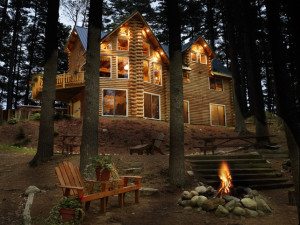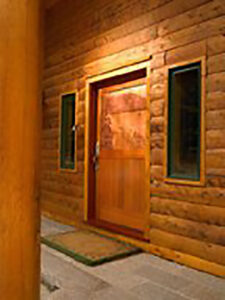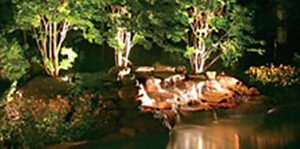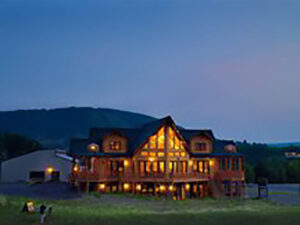Updated May 10, 2024
Exterior lighting ensures your Katahdin Cedar Log home will be safe, secure and well illuminated at night to highlight your home’s stunning details. It used to be that rural exterior lighting consisted of one fluorescent street lamp hung from the side of the barn to illuminate the dooryard. It was bright and effective but it also kept you and your neighbors awake. Now there are a broad spectrum of lighting options and approaches so that you can begin to think about lighting in a whole new way.
Safety is the primary reason to install exterior lighting. But it need not be limited anymore to security lights on the corners of your home or the single front porch light. Architects, landscapers, and lighting specialists can all identify and design lighting that will enhance your home’s appearance, make it feel more welcoming and add drama to the very features of your home you enjoy during the daytime.
Green & Long-lasting LEDs
One big step forward in outdoor lighting is the wide availability of LED light fixtures. Not only are they incredibly energy efficient, LEDs also last a long time—as much as 25 years depending on the usage. This allows homeowners to place lighting in hard-to-reach areas with less concern about replacing them. One way to extend LED life it to connect exterior lighting to a timer or sensor to illuminate only the hours you need them.
Four Types of Exterior Lighting
Lighting designers group lighting into four main groups of illumination:
- Uplighting – to define architectural details or accent mature trees
- Downlighting – to define paths or light large areas
- Zonal lighting – to highlight individual landscape features
- Moonlighting – to cast a lunar glow from trees for a dramatic effect
Focus on the home first
Since your log home will be the first element of your vista to be completed, plan the exterior lighting here first. Highlight your entryway dramatically with a low profile directional light, in addition to the fixture on either side of the door. Take care to adjust the direction of the light so that you aren’t blinded when opening the door.
For a broad porch or deck area, highlight the log walls in between the windows with recessed lights under the eaves. If you have a distinct feature such as an interesting roof line, cupola, or exterior fireplace, make sure to illuminate these features for dramatic effect at night. Downward lights placed low on walls surrounding decks or patios may provide a better ambiance than lighting mounted high on the walls which might be blinding for people sitting in the area.
Most effects can be produced with either uplighting or downlighting sources. The trend now is fewer visible fixtures and more simple lines for fixtures that are designed to be seen. Identify the direction the lighting is designed to go when shopping for exterior fixtures — it may not always be apparent.
 Landscaping with light
Landscaping with light
Lighting can create a welcoming nightscape for the features around your outside areas such as patios, pools, decks and gardens. It can define the outdoor space and make it more inviting to enjoy in the evenings. Work with your landscape architect or gardening expert to identify the dayscape and nightscape effects of gardens and other features in your yard. One thing you’ll want to make sure you have is the capacity to facilitate additional landscape lighting needs in extra breakers and wiring that’s easily accessible.
 Some outdoor lighting needs are easily addressed with simple self-contained solar lighting units that charge during the daylight hours and light pathways garden edges and other areas at night, without added energy usage. Other lighting for pools, trees and plantings can be accomplished with the new low voltage LED units and fiber optic lights. These are easy to install and pose less shock danger for areas where water or inadvertent contact may be possible.
Some outdoor lighting needs are easily addressed with simple self-contained solar lighting units that charge during the daylight hours and light pathways garden edges and other areas at night, without added energy usage. Other lighting for pools, trees and plantings can be accomplished with the new low voltage LED units and fiber optic lights. These are easy to install and pose less shock danger for areas where water or inadvertent contact may be possible.
When installing landscape lighting, you’ll want to make sure to allow an extra coil around the light fixture to allow for flexible placement as the seasons change. Any buried wiring needs to be run through PVC tubing to protect against chewing pests. Exterior lighting can set the crowning touch on your cedar log home, so remember to include it in your plans.
